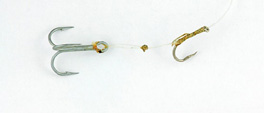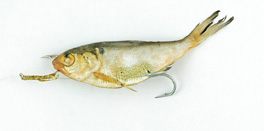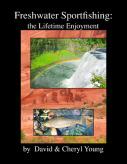Minnows
Most of the states that I fish in have a restriction against using live minnows to fish with. This prevents rough fish from being transplanted. Also you cannot use game fish minnows for bait.
It’s best if you catch the minnows from the water that you’re going to fish. Cast nets and minnows traps are useful tools. A minnow net or window screen can be used.
My favorite rig is an ultra light spin rod with light line. I hook the minnow between the eyes and cast it out as far as the weightless tackle will allow. I like to have the minnow sink slowly. As it sinks, I give it a few short twitches. I want it to look like a crippled minnow that’s an easy catch. Once it settles to the bottom, I lift it up and make about a four foot retrieve and lower the rod to allow it to sink. This erratic up-and-down, stop-and-go retrieve mimics a sick minnow. This method is the best one I’ve found. Sometimes, if my minnow supply is plentiful, I will fish two minnows. They are both impaled through their eyes but one is upside down. This way a flashy side is always visible as it sinks and struggles upwards on the retrieve.

I usually fish shiners, thread fin shad, sculpin, and other closely related minnow species. With them I’ve taken channel catfish, oversized perch, walleye, northern pike, bass (large and small mouth), panfish (bluegills and white bass), and all of the trout species. It works because the technique imitates a crippled minnow which was collected from the water that I fished. It is a natural, native bait fish.
When you are fishing for chinook salmon in the Pacific Northwest, sardines are great baits. Up and along the coast they are sold in sporting good stores and even in some of the grocery stores.
I rig them with an end loop and a sliding nail knotted octopus style hook. A threader places the loop into the fish’s mouth and out in front of its tail. This loop is now attached to a sharp treble hook. Next, slide the nail knotted hook and place it vertically under the jaw and up through the skull. Slide this hook down so the bait is curved like flatfish. This cupping form allows the fish to wobble in the current.

This rig is fished directly downstream from an anchored boat. A leader spreader with another loop about three to four feet long is where the sinker is attached. A bank sinker is used. The minnow and its leader is about five feet long and directly trails the three way spreader. This rig is not cast but walked back down from the boat by lifting the sinker and letting out line

as it sinks back downstream. Walk it downstream about 60 feet behind the boat. You need enough weight so the sinker holds on the bottom at that position. Now place the rod in a secure rod holder. The current causes the sardine to wobble back and forth. You don’t want it to spin but to wobble back and forth. Now you wait for a migrating salmon to swim up from behind and nail the sardine. The strike is so hard that you need a secure rod holder. The fish run downstream and the hook set is easy--just tighten up and the fight is won.

The place you anchor your boat is vital for success. Salmon usually travel upstream in shallower water. Water that is four to six feet deep is best. The prevailing flows determine where to anchor the boat. A side finder or the video sonar can tell you how far away the fish are migrating. Move the boat so the fish migrate right underneath it.
I’d love to fish live minnows on a bobber, but the states I fish in prohibit this. I envision a lightly hooked minnow that struggles to return to the bottom for safety but the bobber keeps him out in the open where he is an easy target. I have not practiced this method, but I envision that it would be effective.

© 2025 The Gale Group, Inc. All rights reserved.
© 2025 Perigee Learning LLC. All rights reserved.
LoveTheOutdoors.com is owned and operated by Advameg, Inc. © 2025 Advameg, Inc.
Camping Adventures • Dutch Oven Cooking • Sports Knots
Fly Tying • Freshwater Fishing • Fly Fishing

